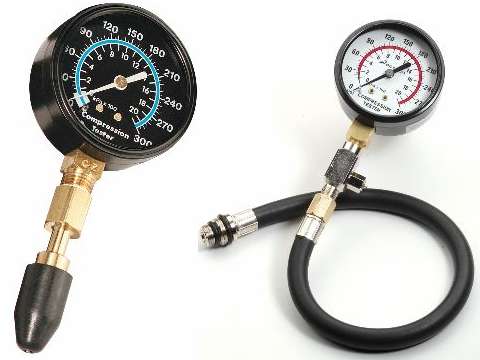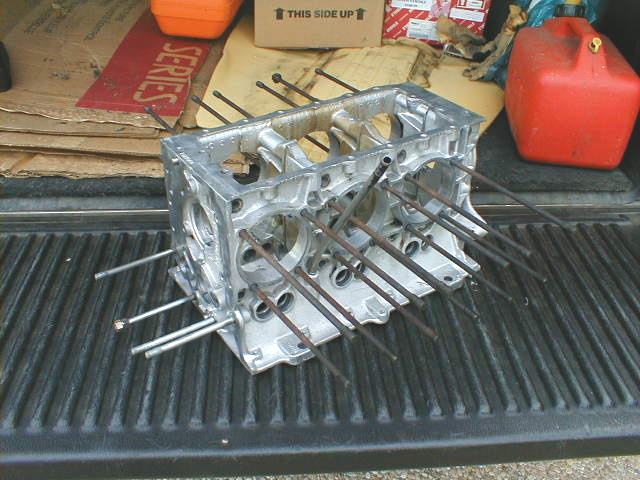


If you cannot find anything wrong with the normal crankcase ventilation system, you must assume that there is a problem with one or more cylinders. The first diagnostic step would be to remove the spark plugs and then perform a compression pressure test in each cylinder. The standard is 130 psi, with no more than 20 psi variation between cylinders. The procedure is outlined in the shop manual. Two types of compression testers are generally available, as shown below. The type with the flexible hose generally works better with Corvair engines, as it is easier to gain access to the spark plug holes with this type of tool.

Normally, a low cylinder pressure reading would be followed up with a cylinder leakdown test, which requires more-specialized testing equipment and an air compressor. This test can tell you if the low cylinder pressure is due to excessive piston blowby, a leaky intake or exhaust valve, or a problem with a cylinder head gasket. However, if the compression test points to one or more cylinders with abnormally low compression readings, that information coupled with already identified but unexplained excessive crankcase pressure buildup would likely indicate a piston or piston ring problem and the necessity of removing the cylinder head(s) to determine the cause and to make the necessary repairs.
Hopefully your problem is nothing more than a fault in the crankcase ventilation system, which would be relatively easy to repair. If it turns out to be one or more damaged pistons/rings or cylinder barrels the repair will be more time-consuming and costly.
Personally i don't believe in the concept of just re-ringing one or more cylinders. If the cylinder barrels and pistons/rings are worn out and in need of replacement, you are really looking at a complete engine overhaul to determine the condition of the rest of the engine. The extra steps involved will generally produce a much better, long lasting and rewarding outcome. The process can be a real confidence and knowledge builder, as well.
You would normally remove the engine and transaxle from the car, separate the engine from the differential, and then completely disassemble the engine for cleaning, inspection, and the replacement of worn parts. This might include a new camshaft, timing gear and hydraulic lifters (not always needed — you may decide to reuse these components (mark the lifters to reinstall them in the same locations they came out of to match the cam lobes they have worn-in on). But if the engine has accumulated a lot of mileage and years of use, i would recommend a new camshaft and aluminum timing gear — properly assembled by the vendor, like Clark's Corvair Parts. Proper installation of a new aluminum timing gear is a critical operation that must be done properly, and Clark's offers this service when you order the new components from them. New lifters should be installed with the new camshaft. The crankshaft must be carefully inspected, and if the journals measure OK, simply install matching bearing shells for proper clearance.It is possible to reuse pistons and simply hone the cylinder barrels, but if they are worn excessively, new pistons, machined cylinder barrels, and new rings may be on your agenda. Having the heads reconditioned at a good machine shop that can handle Corvair heads means a valve inspection and reground valves/valve seats and inspecting and reconditioining the valve guides. New valve springs are also a possibility. Of course new seals and gaskets through the engine will be needed. Reconditioning or upgrading the distributor (possibly to switch to a breakerless electronic ignition), new plug wires and spark plugs, and a carburetor rebuild are part of the equation. If the transmission is a manual transmission, an inspection and reconditioning of the clutch assembly is also part of the job.
I did my first Corvair engine overhaul on a 1963 Corvair 500 (Powerglide automatic) during my summer vacation in 1969 when I was sixteen. It was slow going and I learned a lot. My father provided the garage, tools, funding, and shop manuals, but he had been transferred by his employer from Northern California to Southern California, so I was pretty much on my own to learn the process of removing and overhauling an engine. If you are inclined to take on such a learning experience, you can download and read through the 1961 Corvair Shop Manual and the 1962-1963 supplement at no cost to get an overview of the work involved, using the following ...
The link below will provide you with a list of useful websites that are Corvair-related. Some of the links will lead you to an extensive technical library that will allow you to download shop manuals and other technical references in
Adobe Reader format at no cost. There is also a link that will help you to locate nearby CORSA (Corvair Society of America) club chapters. You will also find a list of essential Corvair parts suppliers. Clark's Corvair Parts in Shelburne Falls, MA is the biggest and oldest Corvair supplier in the world. You will find a link that can provide you with a series of videos that amount to a tour of the Clark's Corvair Parts facilities. Parts suppliers such as this truly make our Corvair hobby possible.
Common and Useful Corvair Websites
 viewtopic.php?f=225&t=6007
viewtopic.php?f=225&t=6007
If there is a CORSA club chapter near you, you might consider joining it to get to know other local Corvair owners, and discuss the issues you are having with your 1963. In addition to advice, you may even get offers of technical training and help to assist you in the project. Their knowledge of local machine shops and parts suppliers can also be invaluable.

I would like to encourage you to expand on your first post and tell us more about yourself, as well as about your Corvair. If you can provide your personal assessment of your mechanical skills and abilities, that would help a lot. Members of the Corvair Forum love to be helpful in assisting other Corvair owners with technical support and advice, but it helps a lot if we have some understanding of your technical background and mechanical abilities, your Corvair-related knowledge, etc. Helping us to know more about you will help us to write comments to you that are tailored to your needs and experience. Knowing your location can also be useful, as that information can sometimes suggest possibilities and options.








 1966 Corvair Corsa Convertible
1966 Corvair Corsa Convertible

 1966 Corvair Corsa Convertible
1966 Corvair Corsa Convertible
 1966 Corvair Corsa Convertible
1966 Corvair Corsa Convertible